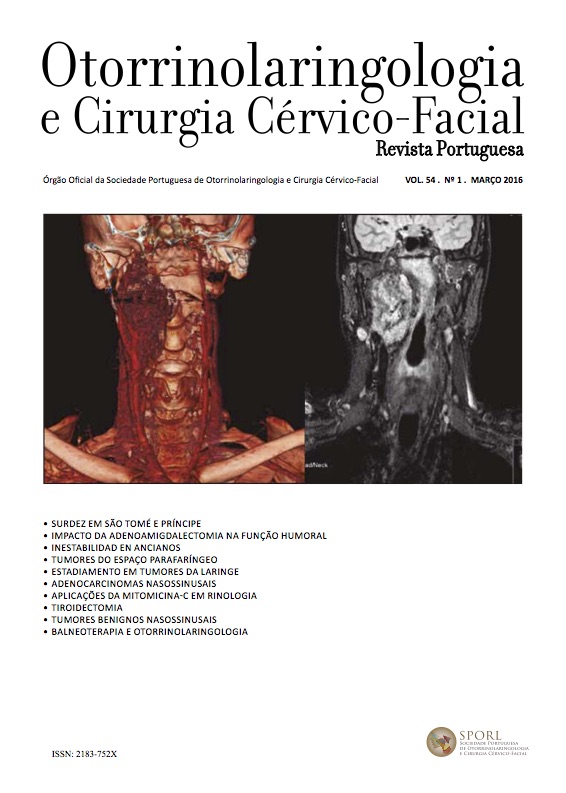Sinonasal adenocarcinomas: Experience of Lisbon Oncology Institute between 2000 and 2014
DOI:
https://doi.org/10.34631/sporl.330Keywords:
tumors, nasal, sinonasal, adenocarcinomaAbstract
Objective: To analyze treatment outcomes, including overall and disease-free survival rates, of patients with sinonasal adenocarcinomas.
Methods: Retrospective study of patients with sinonasal adenocarcinoma treated in IPOFGL between 2000 and 2014.
Results: We identified 33 patients; 17 were women and 16 men. Average age at diagnosis was 65.6 years and median follow-up was 39 months. Ethmoid sinus was the most frequent location; 51% presented at AJCC stage IV. Surgery with adjuvant radiotherapy was used in 70%. Overall survival at 36 months was 57.6%, with 40.5% disease-free survival. Recurrence was caused by local failure in majority of cases. Survival was decreased significantly in patients with sphenoid sinus involvement (p=0.038), skull base invasion (p=0.003) and recurrence metastatic disease (p<0.05).
Conclusions: Complete surgical removal with postoperative radiotherapy remains the standard treatment modality. Sphenoid sinus and skull base invasion, and development of distant metastasis portend for poor prognosis.
Downloads
References
Bhayani MK, Yilmaz T, Sweeney A, Calzada G et al. Sinonasal
adenocarcinoma: A 16-year experience at a single institution. Head
Neck. 2014 Oct;36(10):1490-6.
Lund VJ, Stammberger H, Nicolai P, Castelnuovo P et al. European
position paper on endoscopic management of tumours of the nose,
paranasal sinuses and skull base. Rhinol Suppl. 2010 Jun 1;(22):1-143.
Orvidas LJ, Lewis JE, Weaver AL, Bagniewski SM et al.
Adenocarcinoma of the nose and paranasal sinuses: A retrospective
study of diagnosis, histologic characteristics, outcomes in 24 patients.
Head Neck. 2005 May;27(5):370-5.
McMonagle BA, Gleeson M, Nasal Cavity and Paranasal Sinus
Malignancy. In: M. G. Scott-Brown, Otorhinolaryngology, Head and
Neck Surgery, 7th Edition, Londres, Edward Arnold Publishers Ltd.,
:pp2417-36.
Kleinsasser O, Schroeder HG. Adenocarcinomasof the inner
noseafter exposure to wood dust. Morphological findings and
relationships between histopathology and clinical behavior in 79
cases. Arch Otorhinolaryngol. 1988 Mar;245(1):1-15.
Lund VJ, Chisholm EJ, Takes RP, Suárez C et al. Evidence for
treatment strategies in sinonasal adenocarcinoma. Head Neck. 2012
Aug;34(8):1168-78.
Cantu G, Solero CL, Mariani L, Vullo SL et al. Intestinal type
adenocarcinoma of the ethmoid sinus in wood and leather workers:a
retrospective study of 153 cases. Head Neck. 2011 April;33(4):535-42
Bernardo T, Ferreira E, Castro Silva J, Monteiro E. Sinonasal
Adenocarcinoma – Experience of an Oncology Center. International
Journal of Otolaryngology and Head & Neck Surger. 2013;2(1):13-6.
Veloso-Teles R, Ribeiro I, Castro-Silva J, Monteiro E. Adenocarcinomas
of the sinosal tract: a case series from an Oncology Centre in Northern
Portugal. Eur Arch Otorhinolaryngol. 2014 Sep.
Hayes RB, Raatgever JW, de Bruyn A, Gerin M. Cancer of the
nasal cavity and paranasal sinuses and formaldehyde exposure.Int J
Cancer.1986 April;37(4):487-92.
Leivo I. Update on Sinonasal Adenocarcinoma: Classification and
Advances in Immunophenotype and Molecular Genetic Make-up.
Head and Neck Pathol. 2007 Sep;1(1):38-43.
Choussy O, Ferron C, Védrine PO, Toussaint B et al. Adenocarcinoma
of Ethmoid: A GETTEC Retrospective Multicenter Study of 418 Cases.
Head Neck. 2008 Mar;118(13):437-43.
Nicolai P, Castelnuovo P, Lombardi D, Battaglia P. Role of
endoscopic surgery in the management of selected malignant
epithelial neoplasms of the naso-ethmoidal complex. Head Neck.
Dec;29(12):1075-82.
Van Gerven L, Jorissen M, Nuyts S, Van den Bogaert W et al. Long–
term follow-up of 44 patients with adenocarcinoma of the nasal cavity
and sinuses primarily treated with endoscopic resection followed by
radiotherapy. Head Neck. 2011 Jun;33(6):898-904.






